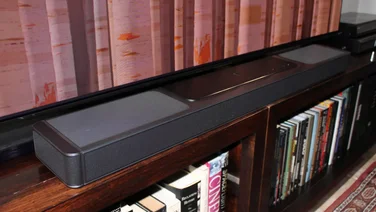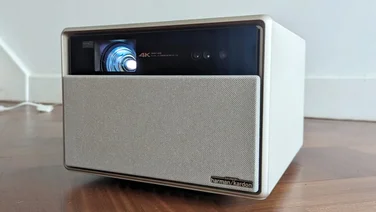To help us provide you with free impartial advice, we may earn a commission if you buy through links on our site. Learn more




- Bold, spacious, punchy sound
- Great standard of build and finish
- Covers DTS:X as well as Dolby Atmos
- Can sound vague and slightly ponderous with music
- Singular aesthetic
- Not remotely short of competition
A big, good-looking soundbar that wears its bulk lightly and manages to look like a Marshall product without being a complete design exercise, the Heston 120 soundbar is a real contender. It’s specified to deal with Dolby Atmos and DTS:X content, has an HDMI pass-through that can deal with 4K at 120Hz and Dolby Vision HDR, and has 11 drivers to deliver spatial audio, rather than relying on digital sound processing.
And when it comes to serving up the spatial audio stuff, the Heston 120 bears comparison with the best of its price-comparable rivals. It’s a big, bold and well-organised listen, with ample dynamic headroom, a convincing soundstage and a real facility with detail retrieval.
Its insistence on using its entire driver array at all times, though, is a double-edged sword. A lot of what makes it good to listen to is rather compromised when playing 5.1 -channel material, and when it’s given a stereo signal to deal with it can struggle. Which means that if you’re after a soundbar to give you an authentic taste of spatial audio, the Heston 120 is a strong contender. If you’re after a soundbar to deal with audio content of all types, though, it’s a slightly more qualified success.
Marshall Heston 120 review: What do you get for the money?
Put £899 Marshall’s way for a Heston 120 soundbar and you get two very distinct things: a bold aesthetic and an extremely thorough specification.
Let’s deal with the second of those things first. The Heston 120 is a sizeable (1,100 x 145 x 76mm, WDH) soundbar that’s designed to offer an impression of 5.1.2 spatial audio from any source able to provide it. To achieve this, it’s fitted with an 11-driver array (a pair of 127 x 51mm “racetrack” bass drivers, a couple of 76mm mid/bass drivers, two 20mm tweeters and five 51mm full-range drivers) variously facing forwards, upwards and sideways from the ends of bar.
Eleven blocks of Class D amplification do the business, delivering an all-in total of 150W of power, which by any reasonable measure really ought to be plenty. And on the subject of plenty, Marshall suggests this is an arrangement that’s good for a frequency response of 40Hz to 20kHz.
Getting audio information on board the Heston 120 can be done a number of ways. The best results will come from using the HDMI eARC input connected to the relevant socket on your television, and Marshall’s inclusion of a second HDMI socket is a) very welcome for those of us with big systems or uncooperative TVs, and b) not something every price-comparable rival includes. There’s an Ethernet socket, of course, and a digital optical input in case you’re inexplicably spending big money on a Dolby Atmos soundbar but own a TV that predates HDMI.
Wireless connectivity consists of dual-band Wi-Fi 6 and Bluetooth 5.3 with SBC and AAC codec compatibility. Using Wi-Fi (or Ethernet) allows compatibility with both Spotify and TIDAL Connect, as well as Apple AirPlay, while Bluetooth is a nice courtesy in case you use an alternative music streaming service or have guests you’d like to involve.




Any and all incoming information is dealt with by a digital-to-analogue converter that’s compatible with every worthwhile file type, including FLAC and WMA (and quite a few less worthwhile ones, too). But the best news of all where incoming information is concerned is that the Heston 120’s HDMI sockets are compatible with 4K 120Hz and Dolby Vision HDR, and are able to deal with DTS:X spatial audio as well as Dolby Atmos. Again, this is not something every price-comparable rival can match.
As far as that bold aesthetic is concerned, it’s Marshall business as usual here, but on a larger scale. A premium price demands a little pride of ownership, of course, and perceived value is important. It seems safe to say the Heston 120 provides it.
A mixture of faux leather, metal, some quite tactile plastics and a quantity of treated fabric that constitutes the ‘salt and pepper’ wraparound grille goes towards creating a harmonious, mildly (and typically) rock’n’ roll kind of look that’s elevated no end by a big, confident brand logo front and centre. A good portion of the Heston 120 is repairable and/or replaceable, too, which is straightforwardly commendable.
The top of the soundbar features a gratuitous but very enjoyable nod to Marshall’s (admittedly glorious) heritage. There are three amp-inspired knobs here, controlling volume, bass and treble levels, input selection and play/pause. Nearby are three small buttons that give access to three presets, and there’s another button allowing you to cycle through your four EQ modes: music, movie, night and voice. Control of a more extensive kind is also available via the free Marshall control app, available on both iOS and Android.
What did we like about it?
Of course, you make your own mind up about the looks; if you’ve read this far, it seems reasonably safe to assume you’re not turned off by them. And there’s certainly no arguing with the way the Heston 120 is built and finished. The modular nature of its construction, which allows for repair and replacement of some parts, doesn’t do any harm in this respect either.
But the most enjoyable thing about this Marshall soundbar is the way it makes spatial audio information sound.




With a 4K UHD Blu-ray of Deepwater Horizon playing (dubious film, excellent Dolby Atmos soundtrack), the 120 is a spacious, well-defined and vigorous listen that’s more than capable of doing justice to the outstanding mastering on this disc.
There’s significant width and depth to the soundstage the Heston 120 creates, and more than a suggestion of the height that’s basically the whole point of a spatial audio soundtrack. Positioning and movement is convincing, and the Marshall does good work in allowing effects to travel the full distance of the stage smoothly. This openness means that spaces get as much emphasis as occurrences, and the overall presentation is solidly and confidently dealt with.
There’s appreciable presence at the bottom of the frequency range, but as well as straightforward wallop, the 120 turns out to be deft and manoeuvrable where bass information is concerned. Control of the attack and decay of low-end sounds is strong, so there’s none of the drone or slur that less accomplished designs can indulge in. There’s obvious variation to the bottom end, too, and lots of detail regarding tone and texture.
The midrange – the essential part of any soundtrack – projects well, enjoys similarly impressive levels of detail, and communicates dialogue explicitly. The transition from bottom to mid is smooth, and tonality is nicely consistent, too. The top end is slightly less of a piece, though – it’s slightly flimsy and toothy, and doesn’t need much provocation, volume-wise, to offer a little latent hardness. Still, it’s just as detailed and as varied as everything that’s going on beneath it.




Even with more compressed Atmos stuff from a streaming service, the broad picture is the same. There’s perhaps just a little less positivity to the lowest frequencies, but the 120 remains entirely listenable and actually genuinely impressive.On a pound-for-pound basis, it’s as accomplished a spatial audio soundbar as is currently available.
The control app, too, is a very agreeable performer. It’s clean and stable, and has a room calibration routine; this is fast and accurate and, of course, uses guitar sounds to do its thing. The app allows you to check for firmware updates, has a volume slider, offers confirmation of the standard of audio you’re listening to, and as well as four EQ presets it also has a five-band equaliser so you can fiddle with the levels to your own satisfaction. Some playback control wouldn’t go amiss, but otherwise it’s a very agreeable interface indeed.
What could be improved?
I’ve already mentioned the 120’s fractionally edgy treble response, although in truth this is more of a trait than a shortcoming. No, it’s where lesser audio content is concerned, the sub-spartial audio stuff, that creates some minor issues for the Marshall.
The Heston 120 isn’t the only soundbar that insists on using all of its drivers no matter the type of content it’s being served, and it’s not the only soundbar that sounds less direct, less organised and less convincing as a result. The soundstage, previously so rigorous, becomes rather diffuse and even, in extremis, a little vague when it’s using its 11 drivers to deal with content mixed for six channels or fewer. Low-frequency discipline is less apparent. And the movement of effects loses some positivity, too.
It’s a similar story with music. The Heston 120 is perfectly fine when it’s dealing with music mixed in Dolby Atmos, and every bit as enjoyable as it is when listening to a similarly mixed movie. It does great work with the Atmos mix of De La Soul’s 3 Feet High and Rising. However, creating a convincing image from a stereo mix using 11 individual speaker drivers is a big ask and, ultimately, the Marshall isn’t quite up to it.
Its presentation of stereo music is hazy and, in the most extreme cases, rather ponderous. There’s little of the low-frequency ‘snap’ enjoyed by multichannel mixes, and the soundstage loses a lot of its definition too.
Marshall Heston 120 review: should you by it?
There’s an awful lot to like about the Marshall Heston 120. It’s an real looker in a market where every soundbar seemingly tries to look the same as every other soundbar. It’s easy and quite enjoyable to operate, and it absolutely maximises those Dolby Atmos and DTS:X soundtracks.
In this last respect it’s a match for the best price-comparable spatial audio soundbars around. But if you want this to be your do everything speaker, make sure you hear it dealing with 5.1 – channel and stereo content before you get your credit card out.






